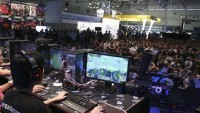Nvidia's G-Sync Display System Comes To Gaming Laptops
| Jotham D. Funclara | | Jun 01, 2015 11:54 AM EDT |
(Photo : Reuters) Nvidia's G-Sync system could potentially eliminate frame rate problems between the monitor and the graphics card.
Nvidia plans to release its G-Sync desktop display system for gaming laptops, effectively revolutionizing gameplay experience in portable PCs. The G-Sync is a variable refresh monitor system, which means it allows the laptop's monitor to match the frame rate of the graphics card installed. This effectively eliminates stuttering, lags, and tearing, especially in today's high-end games.
Like Us on Facebook
Tearing refers to the situation wherein the laptop's graphics card and monitor are out-of-sync and do not refresh at the same time. This allows the GPU to send a completely different frame in the middle of the monitor's refresh screen. This discrepancy in frame rate speeds results in visible distortions in a game's visuals that make it look like things are out of alignment.
G-Sync works by manipulating the monitor display panel's VBLANK or vertical blanking interval, which is basically the amount of time between the monitor's completion of one frame drawing and the start of the next. G-Sync identifies the VBLANK and tells the graphics card that the monitor hasn't finished rendering the frame just yet. This way, the graphics card will render the next frame precisely in sync with the monitor.
According to PC Gamer, the 7 GHz Nvidia refresh G-Sync panels will be initially available in 12 gaming-quality laptops. Nevertheless, it only revealed information on six models to date, including:
Asus G751
Gigabyte Aorus X7 Pro-Sync
Gigabyte Aorus X5
MSI GT72 G
Clevo P770ZM-G
Clevo P750GM-Z
Previously, the G-Sync was only available in Asus and Acer external monitors; however, Nvidia's innovative decision to adapt the technology for laptops marks an important stage in the expansion of the PC gaming experience. Nvidia's director for technical marketing, Tom Peterson, tells Network World that he has even bigger plans for the flexible monitor system, saying that it will eventually permeate throughout other devices as well, including mobile phones, and perhaps even virtual reality headsets.
TagsNvidia, gaming laptops, PC, video card, g-sync
©2015 Chinatopix All rights reserved. Do not reproduce without permission
EDITOR'S PICKS
-

Did the Trump administration just announce plans for a trade war with ‘hostile’ China and Russia?
-

US Senate passes Taiwan travel bill slammed by China
-

As Yan Sihong’s family grieves, here are other Chinese students who went missing abroad. Some have never been found
-

Beijing blasts Western critics who ‘smear China’ with the term sharp power
-

China Envoy Seeks to Defuse Tensions With U.S. as a Trade War Brews
-

Singapore's Deputy PM Provides Bitcoin Vote of Confidence Amid China's Blanket Bans
-

China warns investors over risks in overseas virtual currency trading
-

Chinese government most trustworthy: survey
-

Kashima Antlers On Course For Back-To-Back Titles
MOST POPULAR
LATEST NEWS
Zhou Yongkang: China's Former Security Chief Sentenced to Life in Prison

China's former Chief of the Ministry of Public Security, Zhou Yongkang, has been given a life sentence after he was found guilty of abusing his office, bribery and deliberately ... Full Article
TRENDING STORY

China Pork Prices Expected to Stabilize As The Supplies Recover

Elephone P9000 Smartphone is now on Sale on Amazon India

There's a Big Chance Cliffhangers Won't Still Be Resolved When Grey's Anatomy Season 13 Returns

Supreme Court Ruled on Samsung vs Apple Dispute for Patent Infringement

Microsoft Surface Pro 5 Rumors and Release Date: What is the Latest?













